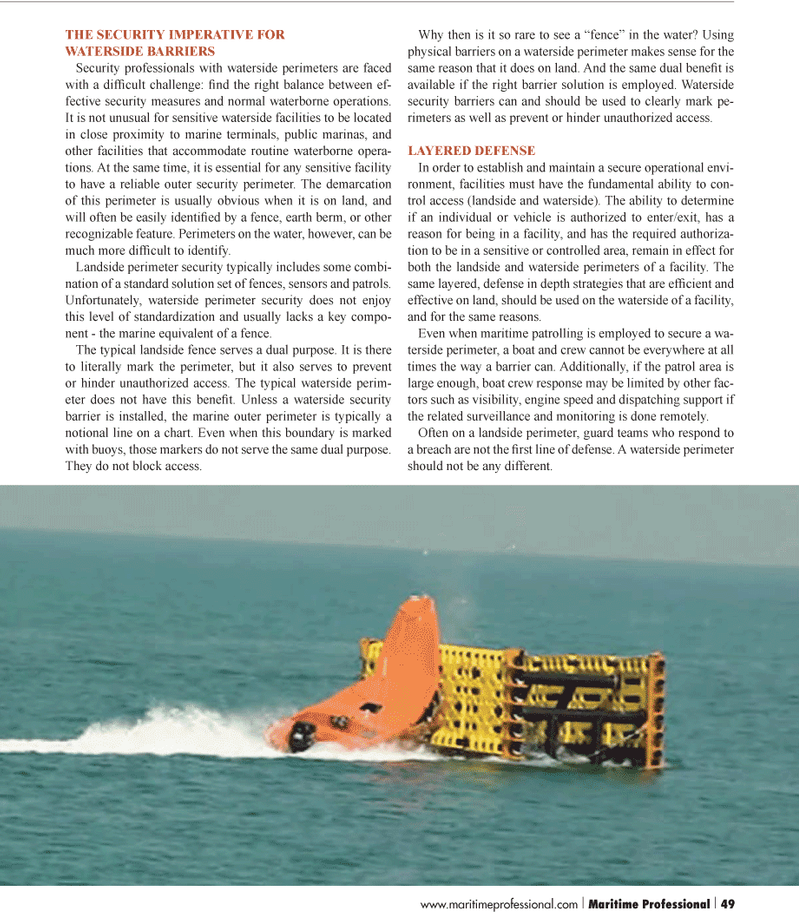
Page 49: of Maritime Logistics Professional Magazine (Q1 2012)
Training & Maritime Security
Read this page in Pdf, Flash or Html5 edition of Q1 2012 Maritime Logistics Professional Magazine
THE SECURITY IMPERATIVE FOR WATERSIDE BARRIERS Security professionals with waterside perimeters are faced witha dif Þ cult challenge: Þ nd the right balance between ef- fective security measures and normal waterborne operations. It is not unusual for sensitive waterside facilities to be located in close proximity to marine terminals, public marinas, and other facilities that accommodate routine waterborne opera- tions. At the same time, it is essential for any sensitive facility to have a reliable outer security perimeter. The demarcation of this perimeter is usually obvious when it is on land, and will often be easily identi Þ ed by a fence, earth berm, or other recognizable feature. Perimeters on the water, however, can be much more difÞ cult to identify. Landside perimeter security typically includes some combi- nation of a standard solution set of fences, sensors and patrols. Unfortunately, waterside perimeter security does not enjoy this level of standardization and usually lacks a key compo- nent - the marine equivalent of a fence. The typical landside fence serves a dual purpose. It is there to literally mark the perimeter, but it also serves to prevent or hinder unauthorized access. The typical waterside perim- eter does not have this bene Þ t. Unless a waterside security barrier is installed, the marine outer perimeter is typically a notional line on a chart. Even when this boundary is marked with buoys, those markers do not serve the same dual purpose. They do not block access. Why then is it so rare to see a ?fence? in the water? Using physical barriers on a waterside perimeter makes sense for the same reason that it does on land. And the same dual bene Þ t is available if the right barrier solution is employed. Waterside security barriers can and should be used to clearly mark pe- rimeters as well as prevent or hinder unauthorized access. LAYERED DEFENSE In order to establish and maintain a secure operational envi- ronment,facilities must have the fundamental ability to con- trol access (landside and waterside). The ability to determine if an individual or vehicle is authorized to enter/exit, has a reason for being in a facility, and has the required authoriza- tion to be in a sensitive or controlled area, remain in effect for both the landside and waterside perimeters of a facility. The same layered, defense in depth strategies that are ef Þ cient and effective on land, should be used on the waterside of a facility, and for the same reasons. Even when maritime patrolling is employed to secure a wa- terside perimeter, a boat and crew cannot be everywhere at all times the way a barrier can. Additionally, if the patrol area is large enough, boat crew response may be limited by other fac- tors such as visibility, engine speed and dispatching support if the related surveillance and monitoring is done remotely. Often on a landside perimeter, guard teams who respond to a breach are not the Þ rst line of defense. A waterside perimeter should not be any different. www.maritimeprofessional.com | Maritime Professional | 49

 48
48

 50
50
